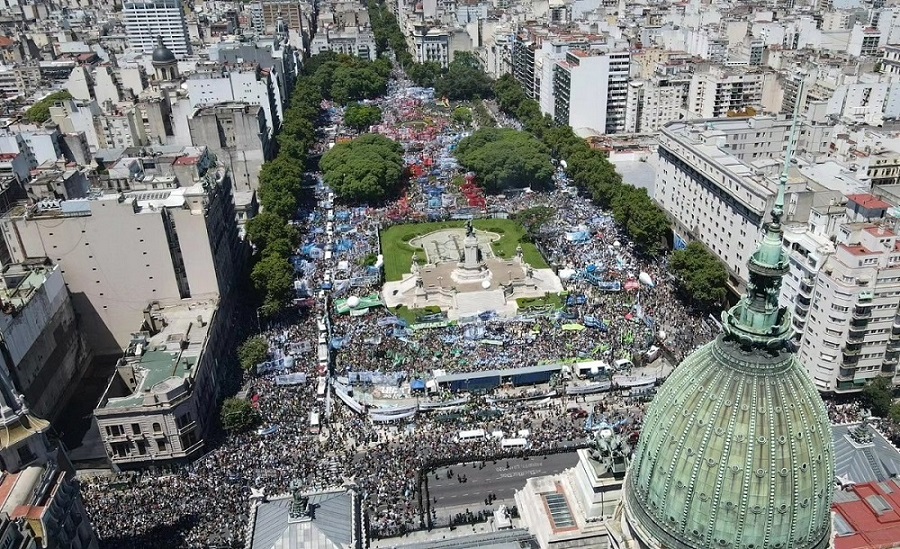
Many assemblies are preparing to take to the streets the day the law is voted on and demand that the union centers hold a new national strike. The background to this orientation was the previous decision, taken in many of the assemblies of Caba, Greater Buenos Aires and UxC to march on the 24th with flags that said: plan of struggle until the DNU, the omnibus law and the protocol fall. repressive. There was awareness that with a strike we were not going to defeat the plan. A great national fight is needed to end Milei’s chainsaw plan.
Our strategic objective is to fight for the general strike. This should not be understood as “more strikes like those carried out by the CGT.” It is not because the left and the combative organizations raised this slogan on 24E. In many assemblies it was also sung: “this strike will not be enough, we need a general strike.”
The Argentine working class has in its history political strikes of magnitude, which are the ones that must be recovered from history: two of them, the Cordobazo and the general strike of 1975, had the force to force the Onganía dictatorship to resign (the first) and tear down the shock plan of Isabel Perón’s government against the working class (the second).
What specifically do we mean by general strike? How can this perspective be developed in CABA?
We mean that the working class, together with the neighborhood assemblies, the Cultural assemblies, the social, women’s and environmental movements, are protagonists of an action that goes beyond the union and social leaders, their organic bureaucratic bodies and demonstrates with that strike who is in charge and who is not. Let’s just think about some examples of what could be paralyzed in the City of Buenos Aires, which is nothing less than the political center of the country: the transportation network that includes the airport, the railway, subways, buses, where millions enter to work from the Greater Buenos Aires; the entire network of the financial system of private and public banks where the rich flee their capital abroad; the port, where from the new Paseo del Bajo in a truck logistics system, is the entry and exit of supplies to the large automotive terminals and other industries. Huge unions such as health and teachers, with a majority of women, who have a special relationship with the communities of their neighborhoods and with students, aware of the demands of our people who can create active unity in common demands against attacks from Milei to health and public education. An action of this type would transform into a metropolitan general strike (CABA and Greater Buenos Aires) capable of defeating Milei’s chainsaw plan that benefits big businessmen by pushing back the rich and powerful for those who govern.
The general strike, however, is not only about paralyzing production, transportation and services, it is also about putting into motion the will and knowledge of the workers together with their allies to define what works and what does not: if, for example, , we decide that it is necessary for transportation to operate from such time to such time, we carry it forward; If we decide to open such a supermarket to supply the population, we do it. If it is necessary to open the schools to operate the dining room for the children, if the Edesur workers want to cut off the power to the Casa Rosada, too! It is an above all active strike where the energy of those who move the City every day imposes its force in the streets, on the pickets, in the occupation of work establishments if the bosses or officials dare to fire people. In this perspective we need to organize and coordinate. What counts is the initiative that comes from below, that of the organizations where the workers together with their allies from the assemblies, from the social movements, from the women’s movement, from the students, are the ones who, self-organized, decide democratically and take into account their hands the tasks to move forward.
Building this horizon is not an easy task. First of all, those who are going to be against it are the union bureaucracies. But it is also important to know that among the different political tendencies that oppose Milei there are different and ultimately conflicting orientations on how to win this fight. There are those of us who trust in the independent deployment of mobilization and organization from below and those who believe that everything must be channeled “under the command” of the “organic bodies” of the traditional structures. For example, in CABA, an important part of the unions is led by the CTAs where dozens of organizations related to Kirchnerism come together. Why then is all this force not put at the service of continuing the struggle? Many voters of Kirchnerism, of the left, state workers, teachers, health workers who participate in the neighborhood assemblies and those of culture, have already begun to show an agenda of struggle that, while demanding measures of struggle, does not wait for the calls of the CGT and the CTAs. We must carry this agenda and fight it also in our jobs and unions and we are willing to take common steps with all the organizations that want to face this fight.
We believe that we are faced with the need to create something new, a new form of organization, a new power that emerges from below, which will have to face the resistance of the State of the capitalists to win. But if we put it on its feet, we would open the possibility of turning the country around from 60% poverty, double-digit inflation, and putting an end to the governments that brought us here. So that the big businessmen are the ones who pay for the crisis and we open the way to fight for our own government, that of the workers.
What is new that we have to contribute from the neighborhood assemblies and the culture assemblies?
The fight has just begun and we have already had more than 30 assemblies in CABA in just 45 days after the government took office. Many of the neighbors are teachers, state workers, health workers, cultural workers, young workers without rights, psychologists, artists, students, retirees. Many of us have participated in mobilizations, for others it is the first time. Some come from having territorial militancy, for others it is new to organize in a neighborhood. In Culture, an assembly movement has emerged, United for Culture, which is strong in the City but also spreads to the main cities of the country. What is the new thing that we can promote from these organizations together with those who want to fight, with those who begin to look for a way out? What path do we have to follow to win this fight?
First of all, in the assemblies we decide, we debate, we propose resolutions and we vote. It is an example because it is what we have to fight to recover in the working class to unleash its energy, to unite the force from everyone’s workplaces, those who are affiliated and those who are not, those who are effective and those who are hired, those who are completely precarious and are the majority of working youth who have no right to anything. In all the neighborhood assemblies and in those of Culture, something also happens that today in the majority of the working class seems like a novelty: different political currents and independent comrades who do not have party militancy but who logically voted for one or the other openly participate. game. Unity is built in the common fight and different orientations are also tested. We vote by majority and minority. We meet in an assembly with freedom of opinion and tendencies and we resolve common actions.
We believe that this process of assembly organization, which is still initial, must be extended to all the neighborhoods of CABA and Greater Buenos Aires. In 2001-2002, when De la Rúa had already fallen, after the battle of Plaza de Mayo, there were 112 assemblies in CABA. On the 24th of the CABA and GBA assemblies we were more than 5,000 colleagues.
The day the omnibus law is voted on we will meet again in the streets. We have to take advantage of the strength that fighting together gives us to found new assemblies in all neighborhoods. Reach thousands of neighbors, workplaces, all fighting movements, the university, tertiary and secondary student movement, to achieve unity in the streets. Cultural activities such as the Parque Patricios Assembly Festival, all the initiatives of the culture commissions of each assembly or the one that the UxC colleagues are going to carry out on February 2, are initiatives that will allow us to add more roots in the neighborhoods, reaching workers, students and youth, to add new wills and together build an agenda of forceful actions that impact national politics.
By a coordinator of all base assemblies
In this note we propose to the neighborhood assemblies and those of Culture to promote a Meeting of all assemblies. In our short experience, the assemblies have made progress in coordinating action. On the 24th we managed to form a column that managed to bring together many. This was possible because from the assemblies we voted for representatives who formed liaison committees that were in charge of communicating between the assemblies to coordinate that unity.
We have to rely on what we have already begun to conquer to advance and unite multiple and territorially extended forces in a new form of organization capable of hitting neighborhoods, workplaces, schools, universities, to stimulate them to build their own assemblies; that they articulate, yes, with our coordinator of assemblies, but also to fight within the unions and bureaucratized social movements for worker and popular unity. From this Meeting we could also seek the relationship with the organizations that are in the space of the combative unions of Ademys, the SUTNA, the Truth and Justice Memory Meeting, etc. with whom we also agree on the need for a fight plan and we have attended their calls from different assemblies.
We propose that this Meeting of Assemblies of CABA and Greater Buenos Aires be open to all assembly members and with delegates mandated by the base assemblies. The mandates are the sovereign decision of the base assemblies and the delegates propose that they be revocable by those who elected them.
Let’s think about it more specifically. If we set ourselves the challenge of building a common action that impacts national politics, to achieve this, coordination has to be built from the bases, with the conviction of the majority of those who are joining the fight. Each assembly can discuss proposals and vote delegates to defend them at a Meeting of delegates from all assemblies. How would we decide when faced with different proposals? As in the base assemblies: it is decided by majority. How is this majority calculated so that it is not arbitrary? Defining a proportion of delegates according to participants in the assemblies, even being able to express majority and minority positions. From now on, at the beginning, the coordination body will mix mandated delegates with colleagues who do not yet have mandates because the assembly dynamics of their territory or workplace have not matured. We will learn to integrate each assembly that joins, respecting the will of the majorities that are already democratically organized for the fight.
These are some ideas that we put up for consideration for debate in the assemblies, with the spirit of reflecting on what strategy can allow us to win and from what perspective we fight.
Source: www.laizquierdadiario.com

